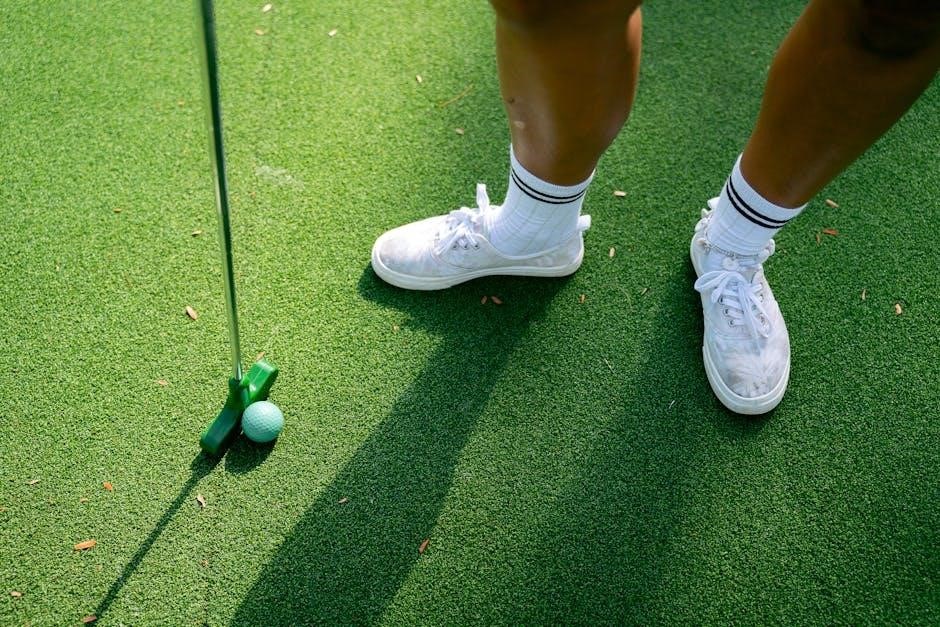The Single Leg Stance (SLS) Test is a widely used balance assessment that evaluates static postural control and stability by having individuals stand on one leg.

Purpose of the Single Leg Stance Test
The Single Leg Stance Test assesses balance, monitors neurological and musculoskeletal conditions, predicts fall risks, and evaluates post-surgical recovery in patients, aiding clinical decision-making effectively.
2.1. Clinical Applications
The Single Leg Stance Test is primarily used in clinical settings to assess patients with neurological conditions such as Parkinson’s disease and musculoskeletal disorders like hip osteoarthritis. It helps identify balance impairments, monitor recovery post-surgery, particularly after total knee arthroplasty, and evaluate fall risk, especially in the elderly. The test is a valuable tool for physical therapists to design targeted rehabilitation programs, ensuring patients regain strength and stability. Its non-invasive nature makes it a preferred method for ongoing assessment and treatment planning in various clinical scenarios.
2.2. Non-Clinical Uses
Beyond clinical settings, the Single Leg Stance Test is utilized in sports training to enhance balance and stability, reducing injury risk. It is also incorporated into fitness routines to improve overall stability and strength. Additionally, the test is used in wellness programs for older adults to promote mobility and independence. In non-clinical environments, such as schools or community centers, it serves as a simple yet effective tool for assessing and improving balance capabilities in diverse populations. Its versatility makes it a valuable resource for both rehabilitation and general fitness purposes.
Procedure for Conducting the Single Leg Stance Test
The test involves standing on one leg with hands on hips, timing duration until balance is lost or feet touch. A stopwatch is used to measure stability.
3.1. Preparation and Equipment
Preparation involves ensuring a safe, flat surface for testing. A stopwatch is essential for timing the stance. Patients should remove shoes and wear comfortable clothing. The clinician demonstrates the test, emphasizing proper posture and balance. A chair or support may be nearby for safety. The patient is instructed to stand on one leg, with hands on hips, and maintain balance. The stopwatch starts when the foot lifts and stops when balance is lost or the foot touches down. The test is typically performed on both legs, with results averaged for accuracy.
3.2. Patient Instructions
Prior to the test, patients are instructed to stand on one leg, with hands placed on their hips, and maintain balance for as long as possible. The test is performed with eyes open initially and may be repeated with eyes closed to assess visual influence on balance. Patients should avoid touching the ground or using their arms for support. A stopwatch is used to measure the duration, starting when the foot lifts and stopping when balance is lost, the foot touches down, or support is used. Clear instructions ensure proper execution and safety during the assessment.

Interpreting the Results

Results are interpreted based on duration of balance, with times below 5 seconds indicating increased fall risk and above 20 seconds considered normal, guiding clinical decisions.
4.1. Scoring and Thresholds
The Single Leg Stance Test is scored by measuring the time an individual can stand on one leg without losing balance. Thresholds are used to interpret results, with times below 5 seconds indicating an increased risk of falls. A duration of 5-10 seconds suggests moderate stability, while 10-20 seconds is considered fair, and above 20 seconds is typically normal. These thresholds help clinicians assess balance impairments and fall risk, particularly in neurological or musculoskeletal conditions. The test is often repeated three times per leg, with the average score used for evaluation. A maximum cutoff of 30 seconds is commonly applied.
4.2. Normative Data and Comparisons
Normative data for the Single Leg Stance Test varies by age and condition. Healthy individuals typically achieve longer stance times, with norms for eyes-open tests ranging from 20-43 seconds for adults aged 18-39. Comparisons across studies show that older adults and those with neurological conditions, such as Parkinson’s disease, often perform significantly lower. For example, a time under 10 seconds is associated with increased fall risk in neurological populations. These comparisons help clinicians assess balance impairments relative to age-matched peers, aiding in diagnosis and treatment planning. Eyes-closed conditions further reduce stance times, highlighting the role of visual input in balance control.

Clinical Applications of the Single Leg Stance Test
The Single Leg Stance Test is clinically applied to assess balance impairments in neurological and musculoskeletal conditions, aiding in fall risk evaluation and postsurgical recovery monitoring.
5.1. Neurological Conditions
The Single Leg Stance Test is highly relevant for assessing individuals with neurological conditions, such as Parkinson’s disease, stroke, or peripheral neuropathy. It helps evaluate balance impairments and fall risk. Patients with neurological deficits often exhibit poor postural control, and the SLS Test provides insights into their static balance capabilities. A cutoff time of 10 seconds has been identified as a significant threshold for fall risk in neurological populations. This test is particularly useful for monitoring disease progression and the effectiveness of rehabilitation interventions in improving balance and reducing fall risk in these patients.
5.2. Musculoskeletal Assessments
The Single Leg Stance Test is a valuable tool in musculoskeletal assessments to evaluate lower limb strength, stability, and functional symmetry. It is particularly useful for patients recovering from knee or hip surgeries, such as total knee arthroplasty or hip osteoarthritis. The test helps identify imbalances in strength and stability between the legs, which can indicate rehabilitation progress or residual deficits. Clinicians use the SLS Test to assess the effectiveness of interventions aimed at restoring musculoskeletal function and to guide further treatment strategies. This assessment is also beneficial for athletes to prevent injuries and enhance performance.
Reliability and Validity of the Test
The Single Leg Stance Test demonstrates strong reliability and validity as a measure of balance and postural stability. Studies consistently show high intra- and inter-rater reliability, with minimal variability in repeated measures. The test correlates well with established balance assessments, confirming its validity in evaluating static postural control. Its ability to predict fall risk further supports its clinical utility. The test’s simplicity and standardized protocol enhance its reliability across diverse populations, making it a dependable tool for both clinical and research applications.
Modifications for Special Populations
For elderly patients, the test may include support options or shorter durations. Pediatric adaptations involve demonstrations and positive reinforcement to ensure engagement and accuracy.
7.1. Elderly Patients
The Single Leg Stance Test for elderly patients often includes modifications to ensure safety and accuracy. Support options, such as a chair or wall, may be provided to prevent falls. The test duration can be shortened, with a focus on observing balance stability rather than maximum time. Additionally, visual or tactile cues may be used to enhance performance. Clinicians may also assess the ability to transition between standing on one leg and returning to a bipedal stance. These adjustments help identify fall risks and monitor improvements in balance rehabilitation for older adults.
7.2. Pediatric Applications
The Single Leg Stance Test is adapted for pediatric use to assess balance and motor skills in children. Modifications include shorter test durations and the use of games or visual cues to engage young participants. Demonstrations and positive reinforcement are often employed to ensure cooperation. The test helps identify balance impairments in higher-functioning children, such as those with cerebral palsy or developmental delays. Caregivers may assist by providing support or stabilizing the child. Normative data for different age groups is used to track developmental progress and inform rehabilitation strategies tailored to pediatric needs.

Case Studies and Practical Examples
A 65-year-old patient with Parkinson’s disease scored 8 seconds on the Single Leg Stance Test, indicating increased fall risk. After 6 weeks of balance training, their score improved to 12 seconds, reducing fall risk. Another case involved a 70-year-old post-total knee arthroplasty (TKA) patient who initially couldn’t maintain single-leg stance for 5 seconds. Post-rehabilitation, they achieved 20 seconds, demonstrating significant recovery. These examples highlight the test’s practicality in monitoring progress and fall risk reduction in both neurological and musculoskeletal conditions, providing clear, measurable outcomes for clinicians and patients.
The Single Leg Stance Test is a valuable tool for assessing balance, stability, and fall risk in diverse populations. Its simplicity, reliability, and validity make it widely applicable in clinical and non-clinical settings. By evaluating static postural control, the test provides insights into neurological and musculoskeletal function, aiding in diagnosis, rehabilitation, and monitoring progress. Modifications for special populations ensure its versatility, while normative data and scoring thresholds offer clear interpretation guidelines. Ultimately, the SLS Test is an essential assessment for promoting safe mobility and reducing fall risks across various demographics.

Additional Resources
The Single Leg Stance Test is available as a PDF download, offering detailed guidelines and scoring thresholds. Shirley Ryan AbilityLab provides key resources for administration and interpretation.
10.1. PDF Downloads and Guidelines
PDF downloads for the Single Leg Stance Test are available from reputable sources like Shirley Ryan AbilityLab and TherapyCtr. These resources provide detailed instructions for administering the test, including patient preparation, timing protocols, and scoring thresholds. Guidelines often include normative data for different age groups and clinical conditions, such as neurological disorders or musculoskeletal impairments. The PDFs also offer practical examples and case studies to aid clinicians in interpreting results. These materials are essential for ensuring accurate and reliable test administration in both clinical and non-clinical settings.
References
Key references include research articles, clinical guidelines, and instructional PDFs. Shirley Ryan AbilityLab provides detailed protocols for the Single Leg Stance Test, while TherapyCtr offers practical implementation guides. Studies by Smithson et al. highlight the test’s validity in assessing fall risk. Additional resources from med-fom-clone-pt.sites.olt.ubc.ca and icrc.scenari.eu offer comprehensive balance assessment frameworks. These sources collectively support the administration, interpretation, and clinical application of the SLS Test across diverse populations and settings.